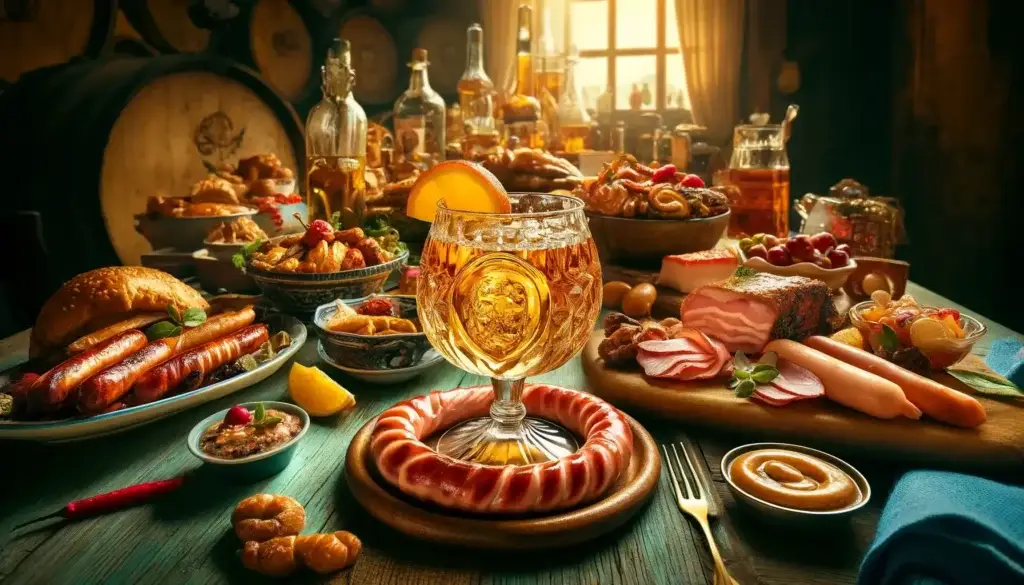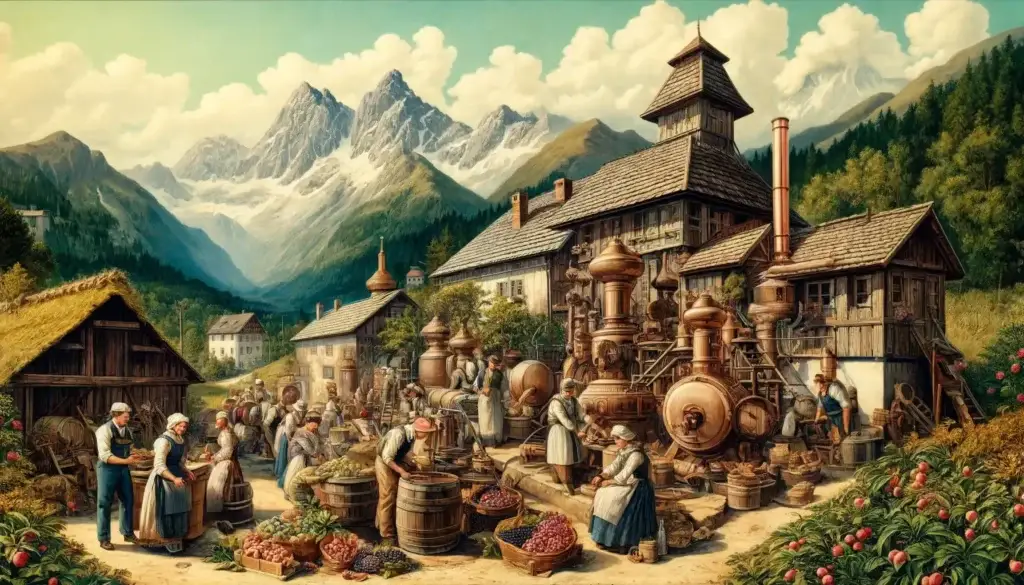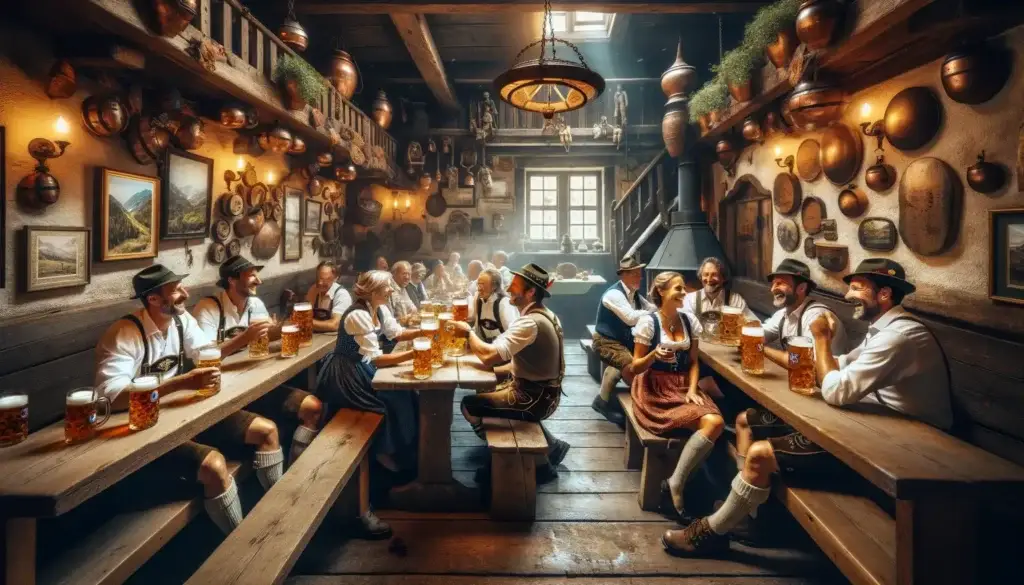

Fried Austrian sausages flavored with mustard and sauces, thinly sliced smoked lard, even pieces of lard with a layer of meat, fish, and seafood, this is the necessary minimum, without which it is impossible to fully appreciate the multifaceted taste of Austria’s national drink, and especially Tyrolean Schnapps. And these are not just words or imaginations. The cultural tradition of drinking this drink and its production process has a specific framework and sequence to reveal a full bouquet of enjoyment.
First, a wine glass with rounded edges and a convex shape. A small portion of alcohol is poured here, and a piece of fruit from which the drink was made is thrown in. For example, pear, plum, apricot. An obligatory attribute is a dessert fork.
Secondly, the correct use of the drink. First, we pick up a piece of fruit, inhale the aroma, drink it, and snack on the alcoholic product. And then everything, as with a regular meal, aperitif or conversation with friends. With meat, lard, smoked meats, fried brisket, sausages, baked carp, etc.

Schnapps is a drink obtained from the double distillation of mash, formed from the fermentation of a fruit, berry, or grain base. The best schnapps is made from wild fruits. From them, the drink absorbs an unmistakable aroma of fruits, which is absent in cultivated fruits. Artificial yeast and sugar are not used to prepare mash. The strength of the finished product is increased from thirty to forty percent. It is served chilled.
Schnapps, a national product, is recognized as a classifier similar to Ukrainian vodka, Japanese sake, and Mexican tequila. Regarding taste, it is somewhere in the middle between brandy and vodka.
Of course, some may say that this is ordinary moonshine. And this will strike a blow to the self-esteem of both Austrians and Germans, who also believe that they are the pioneers of this drink. Such a dispute between these countries has existed for centuries and is not closed even today. Researchers claim that schnapps appeared in these countries almost simultaneously and became a particular hallmark of these nations, despite the difference in promoting this product. In Europe, such a drink can be found more often of German origin. All because Austria exports its product in small quantities, considering it an internal asset. countries
There is another theory of the origin of schnapps, which is called “American.” Such a drink is found among alcohol. It is based on a twenty percent classic schnapps. And it is instead a kind of light liqueur.
So, what is Schnapps? Looking back six centuries, we are surprised to learn that it was sold in pharmacies as a medicine in those days. For stomach diseases, the normalization of the intestines was attributed to the effect of stimulating the body and is therefore beneficial. And only in the eighteenth century was schnapps classified as an intoxicating substance. At the same time, it was always used to digest food. Its name is connected with this, where the German verb “snappen” is interpreted as “to grab and swallow”.
Austria is a nation of practical and goal-oriented people who love precision in everything. At the end of the 19th century, the Museum of Schnapps was founded to study the history of schnapps. Here at the Viennese distillery, five generations of the Fischer family still produce the intoxicating drink following traditional Austrian technology, according to recipes from parents. Of course, the recipes are different, as are the products themselves. For the production of pure schnapps, absinthe, or various liqueurs, everything that can be used for this process will do. Cherry, pear, apricot, potato, apple, raspberry. This is an incomplete list of distilled products, which are conventionally classified by characteristics, such as brandy.
Despite the low sugar content of potatoes, schnapps from this product are considered a classic Austrian drink. When made according to the original recipe, yeast is not added. At home, wine yeast deviates from the defined boundaries and can partially use wine yeast. However, in both cases, the drink has a strong smell of moonshine and a characteristic bitter aftertaste. The process of making a standard drink is mesmerizingly simple. For example, the amylosubtilin and glucavamorin to raise sugar and yeast are added to a mashed kilogram of potatoes and turned into a mixture with half a liter of water to dilute the wort. After a week, the brew will mature, which, after double distillation, is diluted with water, cleaned, and bottled. Everything is simple. But seriously, everything is much more complicated. Today, more than thirty types of schnapps are known and produced in different regions. For example, schnapps made from sweet black Kirschwasser cherries are traditionally preferred in the mountains of the Black Forest. It is even customary to water the cake when serving it. To acquire an almond aroma, which is added to the drink during the fermentation of the fruits and the stones.
An essential story in the production of the drink is that they try to use local fruits for the race. Thus, a good Obstler is obtained from a mixture of some varieties of apples and pears, Zwetschke from plums, Schladerer Williams-Birne from pears, Rumple Minze from mint, etc.
Among the producers of schnapps, the Lehar factory in Lower Austria is worth mentioning. Here, for over a hundred years, a drink known far beyond the country’s borders has been brewed under the August Weinhof brand from Williams Pears, according to old recipes, without sugar, using alpine spring water for blending.
The Erber distillery from Brixen im Thale also has almost five hundred years of reputation. Among its products is the unforgettable taste of the legendary Rowberry Eler brandy, a special series stored in oak barrels. This gives the drink a unique chic.
In the small Tyrolean village of Stanz, located near the town of Landeck, there are more than sixty small distilleries per one and a half hundred families. In particular, the famous Stanzer schnapps are produced here from wild plums of the old Stanzer Zwetschke and Spänling varieties. And at Christoph Kössler’s modern enterprise, schnapps is brewed according to the old family tradition.
The Stanz Brennt distillery festival is held here annually and is dedicated to schnapps, the history of Stanz brand spirit, and the “queen” schnapps plums. A farmer’s market, live music, dancing, a fair, sweets, jams, and various pies are added to this holiday.
What other exciting notes can be added to the culture of making a Tyrolean drink? According to the recipe for making apricot schnapps, you can prepare pear, apple, and any other fruit schnapps without washing the fruit before cooking. And, of course, the race process must be stopped at a minimum strength of at least forty-five degrees.
Another secret related to the preparation of nut and vanilla schnapps. Substances that start the natural fermentation process are added to the recipe – mint, clove buds, dried wormwood, dill seeds, etc. Everything is simple. For this, almost one hundred percent alcohol is used for pouring herbs. After a specific time of infusion, everything is distilled to a distiller.
Interestingly, when making Rumple Minze mint schnapps, many mint leaves are added, and the alcohol percentage is more than fifty percent. For Zwetschke schnapps, only wild plums with stones are used. For peach schnapps, specially grown small peaches with stones are collected, and cherry Kirschwasser schnapps are obtained by triple distillation of cherry mash.
Interesting fact. Hand-picked wild varieties of fruit that are not intended for consumption are used to prepare traditional Tyrolean tincture. For example, an expensive and exciting drink comes from the fruits of the mountain ash Adilitzbeere.
And a few more interesting facts about schnapps. In the homeland of schnapps, Tyrol, private distilleries seriously compete with industrial production to this day. The secrets of moonshine production are passed down through the generations and remain a family secret. And it is in vain that this drink has transformed from a remedy for colds and a myth about a means to prolong youth to ordinary alcohol, which is taken for pleasure.
Moreover, in the Tyrolean Alps, you will be told many more stories about the necessity of drinking this drink at almost every step. They will tell you at what temperature it should be used. What portion will reveal the full taste of moonshine? And you don’t need to think that the temperature difference gives an error of up to eight percent of strength. Believe me, when Austrian vodka is accompanied by meat dishes, smoked meats, sausage, several types of cheese, vegetables, fruits, and fish, the amount of liquid poured into the glass does not matter.
For a particular category of connoisseurs of the Tyrolean drink, I recommend an extreme way to appreciate all the notes of the subtle aroma of the alcohol symphony. The essence of the method, which, like the invention of schnapps, is disputed by the Germans, is that it must be washed down with beer. And not just beer. For pear – light, cherry-dark, apple, and other varieties taste good with both.
What should you pay attention to? In Tyrol, various liqueurs are produced using unique herbs and fresh fruits. Plum, herbal, fruit, blueberry, wild raspberry, peach, walnut, strawberry, sea buckthorn, cherry, strawberry, currant, chocolate, pear, blackberry, terrine, cranberry, and, of course, pine and herbal tinctures.

Another attraction of Austria is winemaking. There are all the necessary conditions for this, taking into account the country’s geographical location on the world map. In general, winemaking in Austria is carried out by small and medium-sized enterprises with a high level of quality. Almost ten thousand Austrian winemakers are small family enterprises where two or three generations often work.
Wine-growing areas are mainly located in the east of the country. First, these are Styria, Lower Austria, Burgenland, and Vienna. The Hoyriher young wine of the same name is produced from the grape variety grown near the capital.
Winemaking is also practiced in other federal states, united in the wine-growing region “Bergland.” However, let’s return to the evaluation of Austrian winemakers worldwide.
A few years ago, one of the world’s most famous wine critics, former head of the European Bureau and senior editor of the Wine Spectator magazine, James Suckling, rated Austrian red wine with the highest number of points. We will remind you that James Suckling is recognized by Forbes magazine as one of the world’s most influential wine critics. This is a recognition of the quality of an expert who tastes dozens of different wines daily. And it was he, conducting a “blind” tasting, who rated the Austrian wine as a “must buy.”
In addition, the world’s best Sauvignon wines, according to the International Wine Database Wine-searcher.com, were recently released. Austrian winemakers from Styria occupied five places in the top ten. Four other companies from Lower Austria and Styria found their place among the top hundred winemakers in the world, according to the US Wine & Spirits Magazine.
At the same time, white wines did not go unnoticed and were highly rated. Grüner Veltiner, Rieslings, Styrian Sauvignon Blanc and the local red wines Zweigelt and Blaufrankisch.
This highly assesses Austria’s winemakers, who have only begun to return to their former glory in recent decades.
Because the real flowering of winemaking in the country was marked from the fourteenth to the sixteenth century. Later, until almost the middle of the nineteenth century, natural disasters, climate changes, and the rapid growth of brewing pushed winemaking in the Bergland region to a critical point. Therefore, the revival of the industry is now of great importance. In Carinthia, for example, the area of vineyards in the district of St. Faith and around Lake Langsee has expanded in the Lavanttal valley and around the cities of Feldkirchen and Klagenfurt. Mainly, the vineyards of the white varieties Burgunder, Sauvignon Blanc, Riesling, Traminer, Zweigelt, and Blauer Burgunder increased.
Upper Austria revives vineyards near Linz, on the Innfirtel hills, and south of the Salzkammergut. Small concessions in wine production have been made in Salzburg and the north of Tyrol in the communes of Heiming and Tarrenz, where Chardonnay and Blauer Burgunder varieties are preferred. This also applies to the Vorarlberg Winemakers’ Association, actively reviving winemaking.
And finally, about wine, which Austrians enjoy tasting. Müller Thurgau, Riesling Grüner Veltliner, dry Heuriger, bright red Schilcher, and white wines Muscateller and Morrillan.
The conversation about wine traditions in Europe should start with France. From the Alsace wine route among the endless vineyards, the annual festival is dedicated to young Beaujolais and takes place near Lyon. Mention the wine regions of Provence, Rhône Valley, Burgundy, etc. And of course about the wine of this country. White Chablis and Cote de Beaune, red Medoc ou Graves
tegers, sweet and dessert Sauternes, Monbazillac, etc.
Italy is known for winemakers from Piedmont, Tuscany, Trentino, Abruzzo, Veneto, Calabria, and Lazio. Here, you can choose among exquisite white, red, and sparkling wines Pinot Grigio, Tocai Friulano, Amarone, Aglianico, Dolcetto, Lambrusco,
Asti Martini, Vermentino, Prosecco.
Spain. The warm climate, topography, and other factors have brought this country to first place in Europe regarding the number of vineyards. There are many wine producers here, and annual festivals are dedicated to this drink’s individual varieties. You can appreciate many sun drinks in Andalusia, Aragon, the Balearic and Canary Islands, the Basque Country, Valencia, and Catalonia. Cava Cristalino Brut, Andimar Blanco, Clos Daynac Blanco, Acta real Tinto, Castaneda, El Cortez and others.
Portugal. Among many wines is a unique wine made from unripe fruits – “Green.” And in the provinces of this country, you can taste the wines of the brands Loureiro, Arinto, Moskatel, Touriga Nacional, Tinta Roriz, Touriga, Franca, and Trincadeira. This is a small part of the wines produced by Portuguese winemakers. Visitors can get acquainted with a broader offer of producers by visiting the annual Wine Festival in Madeira.
And, of course, Austrian wines, which have absorbed the beautiful location and winemaking traditions. Here, it was possible to preserve the old local grape varieties Grüner Veltliner, from which some of the best white wines in the world are produced.
It is worth trying Riesling Grüner Veltliner and Müller Thurgau from the Wachau Valley, white wine Muscateller and Morrillan from Western Styria, and dry wines from Burgenland.

Living next to such a venerable neighbor as Germany, it is challenging to develop the brewing industry. But this does not apply to Austrians. Therefore, the first thing to do on vacation in Austria is taste the “March beer,» produced from October to March. You will appreciate the light, amber Märzenbier, Wiener Lager, sparkling Zwickelbier, and strong Bockbier. And, of course, enjoy regional brands. Salzburg Stiegl, Styrian Gösser and Carinthian Hirter Stiegl is brewed from crystal clear mountain spring water at the factory in a private brewery that is one of the few remaining in Austria.
Gösser is considered by many to be a German brand. This is a false impression. It is one of the oldest brands of Austrian beer, known since the fifteenth century. By the way, Leoben has a factory and museum of beer and brewing.
Finally, restaurants, bars, and local breweries offer beer in different mugs. The main thing here is to make a good decision with the size. Two hundred grams is a Pfiff, three hundred is a Kleine’s Bier or Seidel, and a Krügerl, Halbe, or Großes Bier is a pint. An important detail. The bigger the mug, the cheaper the price. The truth is that at beer festivals, they don’t bother about trifles. The standard for serving a foamy drink is one- and two-liter mugs.
It is cold in the Alps in autumn and especially in winter. Especially at the top of the mountains, when the frosty wind cuts through to the bones. Warm shoes, a down jacket, and soft gloves will not help. How and what to warm up? That’s right, a cup of mulled wine. Or a glass of punch or grog? How not to lose? What is the difference between these drinks?
Glitwein. Translated from German, this is hot wine. Red, rarely dry white or port wine. This drink has been known in Europe for almost seven hundred years; it was prescribed for preventing colds and was called Nippocras. This is a drink that today Austrians call Glühwein; in Italy, it is Vin Brule; in Norway – Glödgad Vin; in Finland – Glögi; and in English-speaking countries, it is known as Mulled Wine.
Today, we enjoy this hot drink with cloves, cinnamon, citrus, vanilla, nutmeg, cardamom, raisins, etc.
According to the classic recipe, Punch is impossible without five components – water, wine, rum, sugar, and spices. Of course, lovers of this drink do not stop improving the recipe. Instead of rum, brandy, or vodka, many non-alcoholic options are being developed, and they are consumed both hot and cold.
It is unpretentious in preparation. In the standard version, two bottles of hot, dry wine add a bottle of brandy, three hundred grams of sugar, an apple, a pear, and spices. Boiled with chopped fruits, add spices to taste, and the drink is ready.
Grog is made from dark rum and hot water. The English admiral Edward Vernon proposed the classic grog recipe and nicknamed it Old Grog. Thanks to him, this drink was officially added to the diet of sailors of the Royal Navy, primarily as a means of prevention against scurvy. Hence, the name “Grog” was established.
For objectivity, we note that in another sense, “groggy” means “unsteady on one’s feet.” This is not surprising. Rum diluted with water and sugar is another drink. Sometimes, hot tea is used instead of water to “soften” the taste. And spices. The exact amount of rum is added to one liter of tea. It warms immediately and for a long time.
In general, studying the topic of alcohol, we see that regardless of which herbs and spices were used for flavoring, the basis remains the product of distillation from correctly selected quality products. Schnapps infused with herbs have a bitter aftertaste, fruit additives add a sweet note, and grain distillate gives the impression of moonshine.
However, when you ordered a bottle of pear schnapps at a restaurant, it was served with a natural large pear inside in a corked and moonshine-filled bottle. What will you think about at this time? That’s right, how did she get there? Let’s drink – we’ll see. They drank. The pear is in place. After the third bottle, the restaurant owner will explain this miracle’s simplicity. This pear grew from the ovary in a bottle tied to a tree branch until it matured.
It is not necessary to moralize on the topic of drinking alcoholic beverages. Everything should be in moderation. Tasting new drinks, discovering new tastes, getting to know unknown sides of the historical past in the territory you considered explored until yesterday. And when you are in cheerful company, with delicious national cuisine and a pleasant drink, for example, a glass of first-class schnapps or a mug of hot mulled wine. Or maybe grog? Everything is in the mood.